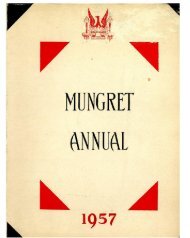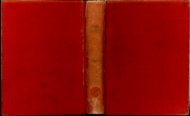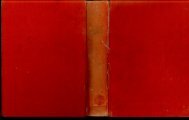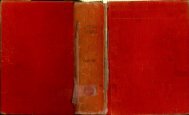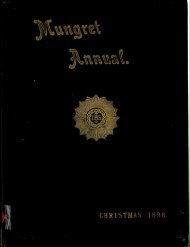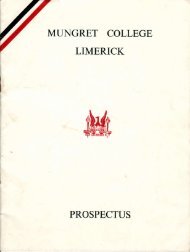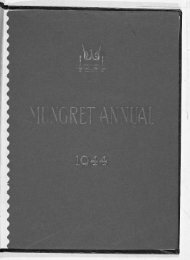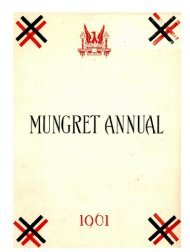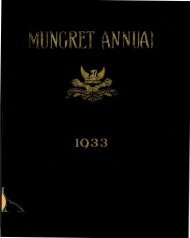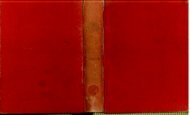Download the Mungret College Annual 1968 - Mungret College Past ...
Download the Mungret College Annual 1968 - Mungret College Past ...
Download the Mungret College Annual 1968 - Mungret College Past ...
You also want an ePaper? Increase the reach of your titles
YUMPU automatically turns print PDFs into web optimized ePapers that Google loves.
especially for Limerick readers - " Caleb<br />
Powell, High Sheriff of County Limerick,<br />
1858, Sums Up His Grand Jury." The<br />
essay presents Powell's memoranda on each<br />
of his Grand Jurors. It is an interesting<br />
document, dealing with names long associated<br />
with Limerick city and county - <strong>the</strong><br />
O'G radys, O'Briens, Roches, Gubbins,<br />
Lloyds, Bourkes, Sheehys and Lyons, to<br />
mention family-names still happily surviving;<br />
and <strong>the</strong> Masseys, Delmeges, Maunsells<br />
and Frends, who have left but <strong>the</strong>ir<br />
name. The Frends, probably <strong>the</strong> least<br />
familiar of <strong>the</strong>se names, were Cromwellian<br />
settlers who settled in Boskell, Co. Limerick.<br />
Towards <strong>the</strong> end of <strong>the</strong> 18th century Boskell<br />
was occupied by Benjamin Frend, who had<br />
an iron leg which many thought <strong>the</strong> softest<br />
part of him. During <strong>the</strong> 19th century <strong>the</strong><br />
family lands passed to <strong>the</strong> Roses of Ardhu<br />
House (" Rose's Avenue "), Limerick, and<br />
<strong>the</strong>y, in turn, in <strong>the</strong> 20th century, gave way<br />
to <strong>the</strong> Ryans and o<strong>the</strong>r native families, who<br />
had kept <strong>the</strong>ir grip on holdings in <strong>the</strong> area<br />
through two centuries of misfortune. Thus<br />
<strong>the</strong> land reverted again to its native owners.<br />
The wide range of subjects covered in<br />
North Munster Studies " has made it<br />
almost impossible to link toge<strong>the</strong>r <strong>the</strong> various<br />
topics treated; <strong>the</strong>re is a lack of chronological<br />
order in <strong>the</strong> placing of <strong>the</strong> historical<br />
essays (Brian Boruma, for example, is<br />
squeezed in between two contributions on<br />
<strong>the</strong> eighteenth century); and individual<br />
readers may be disappointed by <strong>the</strong> absence<br />
of any treatment of <strong>the</strong> Limerick area for<br />
<strong>the</strong> 15th and 16th centuries. Such criticisms<br />
however may seem captious in view of <strong>the</strong><br />
overall impressiveness of so large a work<br />
and <strong>the</strong> generally high standard evinced in<br />
<strong>the</strong> contributions. It contains much material<br />
of interest to <strong>the</strong> serious student of Irish<br />
history and archaeology, and much enlightening<br />
information for <strong>the</strong> general reader.<br />
TM,<br />
D ClflN<br />
Fo/ktales of <strong>the</strong> Irish Countryside<br />
by Kevin Danaher<br />
Once upon a time, people used to amuse<br />
<strong>the</strong>mselves, you know - and <strong>the</strong> night was<br />
often too short for those past generations.<br />
The reason why is indicated by <strong>the</strong> 40 folktales<br />
Limerickman Kevin Danaher, a <strong>Mungret</strong><br />
<strong>College</strong> past-student, heard as a child.<br />
Some 26 of <strong>the</strong>se are international - folkstories<br />
are, perhaps, <strong>the</strong> most cosmopolitan<br />
feature of Irish culture. This collection,<br />
with its very useful introduction and notes,<br />
should assist in dispelling <strong>the</strong> regrettably<br />
common notion that such books are merely<br />
a contribution to <strong>the</strong> children's Christmas<br />
literary market. But anyone - children<br />
included - with <strong>the</strong> smallest spark of<br />
11 soul " will enjoy this book.<br />
MERCIER PRESS, 1967.<br />
It is also a scientist's book: <strong>the</strong> folklorist<br />
deals with <strong>the</strong> study of man. Social history<br />
here links arms with social anthropology,<br />
with exteriorations of deep psychological<br />
forces. Perhaps a few myths seem somewhat<br />
trite? From such as <strong>the</strong>se, a philosopher<br />
will one day sift out " <strong>the</strong> germinal ideas<br />
and fundamental data of humanity's moral<br />
experience "—(Maritain).<br />
The title (while valid) might have been<br />
more definite. I would have liked more<br />
notes, especially on <strong>the</strong> Irish language background.<br />
But it would be unfair to demand<br />
such in a popular book of this kind. Surely<br />
I ought to be satisfied with <strong>the</strong> immense<br />
enjoyment <strong>the</strong> stories <strong>the</strong>mselves afforded<br />
me? —C. T. 6 C.<br />
£I &eda Ihe ftaviq~a&4<br />
One of last year'shiggcst news stories was<br />
<strong>the</strong> attempt by a Breton and a Nova Scotian<br />
to sail from Ireland to Canada in (what <strong>the</strong>y<br />
were pleased to call) a currach. The wouldbe<br />
voyagers had hoped to prove that St.<br />
Brendan had sailed to America fourteen<br />
centuries ago.<br />
The reason <strong>the</strong>y failed was that <strong>the</strong>y simply<br />
had no knowledge, evidently, of <strong>the</strong> type of<br />
vessel used by <strong>the</strong> Irish mariner-monks.<br />
Certainly, St. Brendan and his fellows would<br />
have been horrified at <strong>the</strong> suggestion of<br />
crossing <strong>the</strong> Atlantic in a canoe.<br />
Irish sailors, from very early times, journeyed<br />
back and forth across <strong>the</strong> Irish Sea<br />
and <strong>the</strong> English Channel. Indeed, many<br />
authorities hold that <strong>the</strong> Gaeil, <strong>the</strong> last Celts<br />
to colonise <strong>the</strong> country, sailed directly from<br />
<strong>the</strong> coast of Spain; that invasion took place<br />
about a century before Christ. Of one thing<br />
we may be certain: such a voyage was not<br />
made in canoes.<br />
In fact, Irish mariners - especially <strong>the</strong><br />
sailor-monks - ranged so widely and so<br />
fearlessly that it has been suggested that it<br />
was <strong>the</strong>y who gave <strong>the</strong> Vikings <strong>the</strong>ir early<br />
knowledge of ship-building. After all,<br />
Irishmen reached Iceland, Scandinavia and<br />
even Lapland centuries before <strong>the</strong> Vikings<br />
reached Ireland. Iceland was, of course,<br />
first discovered by <strong>the</strong> Irish - and settled<br />
by <strong>the</strong>m.<br />
Nobody calls more attention to this latter<br />
fact than <strong>the</strong> Icelanders <strong>the</strong>mselves, who<br />
claim to be part Irish and show tremendous<br />
interest in Celtic studies. Our sailor-nionks,<br />
sailing far beyond <strong>the</strong> Hebrides, recorded<br />
icebergs and <strong>the</strong> Aurora Borealis.<br />
Obviously, a much more sophisticated<br />
vessel was used for such voyages than Capt.<br />
Louis Lourmais or his companion realised<br />
when <strong>the</strong>y attempted to follow in Brendan's<br />
wake in <strong>the</strong>ir canoe!<br />
ite] 11




